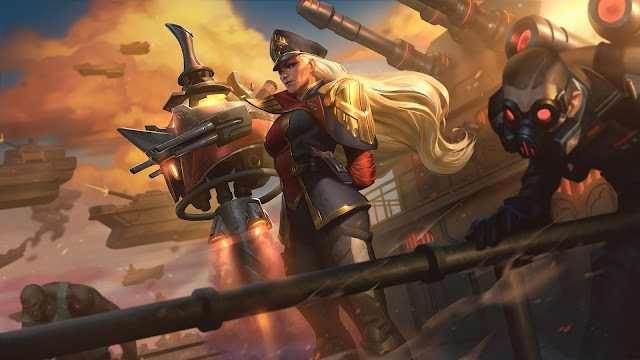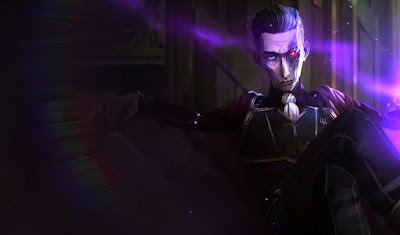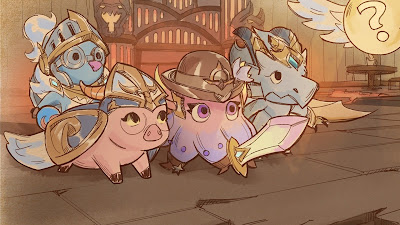
- Red Post Collection: Patch 12.3 & TFT Notes, VGU & Skin Thematic Voting Results, & More
- 2/7 PBE Update: Chroma Assets, Icon Tweaks, Continued TFT Testing, and more!
- 2/8 PBE Update: Continued TFT Set 6.5 Testing & Tentative Balance Changes
- 2/9 PBE Update: TFT Set 6.5 Testing & More Tentative Balance Changes
- Crystal & Withered Rose Skins & Content Now Available!
Table of Contents
Quick Gameplay Thoughts 2/11: Champion Releases
"Whenever we release a new champion, we often get questions like “How did you decide this champion’s new mechanic was fit for the game?” (or, alternatively, something more along the lines of "How dare you?"). We wanted to answer these questions by sharing how we validate gameplay and plan for champion releases and, since I’m the gameplay designer on the latest one, you’re stuck with me. Sorry.
Validating Gameplay
Case Study: Renata Glasc
With each champion, we want to bring something unique, whether that be a new playstyle, mechanic, thematic, or something else entirely. Each release should broaden potential experiences for players rather than push older champions out of their gameplay space. However, new ideas often come with risks, so every possible addition to the roster needs to be carefully evaluated and planned for.
Let’s take a look at how this panned out with the hot topic of the day, Renata Glasc’s W, Bailout. Bailout is intended to create intense, live-or-die moments for her team. With its buff, an ally can push their limits and prove their value even beyond death to get a second chance at life. However, it can also be used on a champion that isn't currently at the brink of death to boost their offensive stats.
As a basic ability, we recognized it could have too much power and lead to unhealthy game states. The potential revive needed particularly extensive testing. To validate the gameplay, we always start out with high level questions like:
We test these questions by adding/removing constraints or tuning the numbers until hopefully eventually the ability is in a reasonable state. If the ability isn’t matching our expectations, we keep on iterating to determine why.
- Does the existence of Bailout lead to game states where opponents feel like there’s no point in being aggressive?
- Does Renata only wait for opportunities to revive allies rather than use Bailout proactively?
- Do opponents feel like they have counterplay options when Bailout is cast on an enemy?
Getting More Granular
Once a mechanic's power level is in the ballpark range of acceptable, we start asking more specific questions to get into fine-tuning:
- How often do Bailout casts result in saving an ally? How often and long do allies live after being saved?
- How often do Bailout casts result in pushing a kill that wouldn’t have happened otherwise?
- What do early game all-ins look like using Bailout?
These give us insight into how the ability can be tuned, or what we call "levers". Different levers tune different aspects of the ability. For Bailout, we have levers that allow us to increase or decrease outputs such as the consistency of revives, the potency of the bonus stats, and the frequency of casts. After enough iterations, we reach a point where we have enough levers and feel the ability is known well enough to release—with a plan, of course.
Post-Release Plan
Post-release plans are, well, plans for what we expect to see and do after champion release. They cover topics like predicted winrates for each bracket, item builds, skill max order, and role priority. If any of the numbers in Live turn out to be significantly off from what we predicted, we’re likely to take action(s) to correct it with the levers we've already identified. Sometimes we include specific "action items" for riskier abilities, which are like playbooks where we describe a possible scenario and list a potential action (or, like, five) to address it.
For Renata Glasc, Bailout is one of those risky abilities we needed to prepare action items for. For example, the potency and frequency of successfully reviving an ally is a potential area of concern. If the frequency is too high, we already have several viable levers from gameplay validation and know what each of them will do:Overall, our goals are to ensure that champions with new mechanics release with acceptable conditions, and that we're prepared for any possible significant gameplay issues. However, even with all our testing, players play thousands more games than we ever could in a champion's whole development. We'll be watching to see how close we were with Renata Glasc and can't wait to see how she plays when she arrives on February 17!"
- Reduce the duration of Bailout's buff to reduce the window of time the unit gets to be potentially revived
- Shorten the revived ally's burndown period so that they burn faster, reducing the chance of them getting a takedown to stop their burn
- Make the takedown window less forgiving by requiring a dying ally to have dealt damage to an enemy within a few seconds, rather than revive off any assist
- Make the actual stat buffs bigger so that she is more tempted to buff an ally who is likely to remain alive rather than one who is near death
New Firecracker Teemo merch
"The adorable and fiesty Firecracker Teemo is ready to lead you into a wonderful new year with our new Lunar New Year Collection."
Miscellaneous
- Squad5 noted a small Renata Glasc change:
People were asking about it - we moved the MS threshold for Renata's walk up to 385, so if you have tier 2 boots she should still use the base walk animation. Yesterday we put it to 380 but since if you have t2 boots + celerity you get to 382 ms we bumped it up.
— Blake Smith (@Squad5lol) February 9, 2022
- Riot August tweeted that he is now lead champion designer!
I'm now @LeagueOfLegends' lead champ designer!
— August UwU (@RiotAugust) February 8, 2022
I learned about game design in college through posts from @MorelloNMST, the lead at the time, and imagined how cool it would be to have a job like that. Now here we are 9 years later! Hope I can have the same kind of positive impact pic.twitter.com/AvOMc6jVWS
- Riot Maxw3ll tweeted that he is the new manager for the champs team!
"Hello friends, like @RiotAugust said, I'm the new manager for the champs team! Mostly I handle the day to day management of the team, but for everyone who hates yuumi, don't worry; I'm still making champs :D"
TFT Arena
- "Mort reflects on the expectation to be highly ranked as a dev."
"TL;DR: In this /dev blog I break down the three reasons why the expectation of a dev to be highly ranked in their game is not a worthwhile effort for creating a better game.
Hi, I’m Mort, Game Design Director for Teamfight Tactics since, well, its launch. Here, I want to chat about the expectations that come with the role of a game dev. That story starts with me finally making Challenger. With Gizmos & Gadgets being our most dynamic set yet, I wanted to prove to myself that I could hit Challenger once and for all. It was a grind for sure and it put me the closest I’ve ever been to burning out, but I’m glad I can finally say that I was part of the top 250 players in our region. But, I’ll save the self-congratulations for another post—right now, I’d like to discuss the expectation that in order to work on a game, you need to be the best at it.
The expectation that to work on a game, you must be at the top of the game's player base is a problem that persists throughout the entire games industry, not just TFT or League of Legends. I’ve had many people say my claims as a dev aren’t valid because I’m not Challenger. I’ve watched coworkers get roasted for only being Diamond, top ∼4% of players. And I’ve seen devs for other competitive games go through similar accusations. And it’s all ridiculous.
Let’s break down the three main reasons why we shouldn’t ask devs to be the very best at their game.
- Time commitment
- Design improvements
- Audience understanding
Time Commitment
Game devs work 40+ hour work weeks, and while a small portion of that work time involves playtests, these playtests are not done on live servers. Instead, they are done in environments where we often are trying our best to break the game, see what fails, and what prevails. We are testing future versions of the game, sometimes the next patch, but oftentimes the next mid-set, or next set entirely—which I would add, creates habits that are not great for climbing the live Ranked ladder. No part of this 40 hour work week consists of climbing the Ranked ladder. Now, ideally, devs are also playing their game a bit outside of work—and trust me, we all are. But how much time are we reasonably supposed to spend playing outside of work? It took me close to 400 games in two months to reach Challenger, which amounts to more than 300 hours in around 8 weeks. If we count that as part of the job, that’s around another 25-30 hours a week. That, in addition to already working full time on TFT, is a recipe for burnout. You want your devs to have a healthy work life balance, and to have experiences outside of TFT to make them well rounded. Family time, other games, exercise, etc. will all make devs more resistant to burnout, while also being better and healthier people overall. The expectation of a dev to be in the top 1% of players (or higher) is an expectation for that dev to work 70 (or more) hours a week—an unreasonable expectation to put on anyone, dev or not.
Design Improvements
Regardless, good devs are still going to PLAY the game they work on. And that’s good! With that time though, what do we want them to be doing? Do we want them grinding the Ranked ladder by playing the way high level guides already tell them to, practicing known combos or one tricking a single champ? OR, would you rather them use that time to figure out ways to make the game better? Trying champs they don’t play so they can understand what the pain points are, or figuring out why decks and cards don’t work well at high level? If you want a better game you want the latter. I’ll say personally one of the reasons I never hit Challenger in previous sets was because I always focused on trying the non-meta stuff to discover what needed to be improved. But, during this climb, I’ve avoided comps I’m not comfortable with, I’ve been sticking to the same few strong early game items, and I’ve played to win as opposed to learn. This isn’t what a game dev should be doing. We should want our devs playing reroll Vi to figure out how to make it viable, or trying Locket builds to see if the item needs to be buffed. Devs already know what wins, we see it every day in our data, we hear about it everyday from our top players, we live it every day in our balance discussions—what devs don’t see often enough are the things that are underplayed, underpowered, or just have yet to be discovered, and that’s what a dev should be playing the game for.
Audience Understanding
If you enjoy the game you play, you want it to be popular so the game can thrive. The way to do that is to increase the games’ appeal and accessibility for a wider audience. The truth that competitive players often push back on is that if you want millions of players, you need a game that millions of players can enjoy. High level players and more junior designers will often make the mistake of designing games for themselves, which leads to very inaccessible games. And yes, TFT is guilty of this to an extent. But it’s something we are getting better at with more accessible big vertical traits that, while aren’t the most powerful way to play the game, they are viable. But further than this level of accessibility, it’s important to have a variety of developers with a diverse set of experiences to make sure the game can appeal to any skill of player, and any play style. That’s why we consistently ask ourselves what makes playing TFT fun—not just for ourselves, at our skill and preferred playstyle, but for all our players.
Take our iterations on Silco that Chloe “Alice of Clubs” Wright and the rest of the team made for our mid-set, Neon Nights. An early version of Silco had him never auto-attack. Instead, he gained mana each second for each living ally, and casted a buff on his allies as his spell. But the really exciting cast came at the end of the fight, where he summoned a Monster, similar to the Monstrosity from Reckoning’s trait, Abomination. But Silco could only summon the Monster when he ran out of allies to buff with his spell. This complication created confusion, because on the surface it asked you to do two opposite things: have a lot of allies, and have few allies.The goal had been to make it so that the player needed to keep their whole team alive for long enough to allow Silco’s big cast to go off, but in practice it was just confusing, clunky, and required the player to build an all-tank army to stall for the big cast to go off. Gameplay like this can add a ton of unique depth and challenge to the game, trying to form the perfect comp to execute on, but in practice they end up extremely unfun to play against and aren’t intuitive for most of our players. With Silco having such broad appeal, Chloe and the team went back to the drawing board in efforts to create a play pattern that was easier to understand and more fun than the stall till you win strategy.
With that in mind, we returned to ask ourselves: what makes playing TFT fun, for everyone?
And I’ll tell you now that answering this question is a hell of a lot easier if you have a diverse group of devs. It takes more than just a bunch of high level players to find and extract the essence of what makes a game fun. It takes a variety of life experiences, game philosophies, play style preferences, and skill levels. And I’m proud to say that on the TFT team we finally have that—and it shows with the continued popularity of Gizmos & Gadgets.
Closing
Lastly, I wanted to bring attention to the psychological stress that comes with constantly performing to the best of your ability while playing your favorite game. It’s so simple that we often forget: we are gamers because gaming is fun. If a dev wants to kick back and reroll while catching up on their latest binge, they should be able to enjoy that.
I could go on and on, but I want to close out with the fact that hitting Challenger took a lot out of me. I’m lucky enough to have a supportive wife who wanted me to do it to “prove the haters wrong.” But I’ll likely never push for a high rank this way again. Pushing for higher ranks on the ladder is not the best use of time if the ultimate goal of the TFT dev (or any other game) is to make their game the best it can be. And I hope, for those of you reading this, that you’d agree. That you want your favorite game’s devs to not burn out, and to be the best they can be, so that your favorite game continues being just that: your favorite."
- Here's a new feature coming in 12.4:
Coming patch 12.4, you'll be able to see what foes you've yet to fight this stage, with a cute little icon alluding to their imminent destruction!
— Teamfight Tactics (@TFT) February 10, 2022
We've wanted this since seeing it in other apps to help us focus on the things that matter: rolling down, scouting, & not pivoting. pic.twitter.com/NjaLH2Rkov
- Here's a look at each of the TFT Neon Nights Tacticians:
Other Games
Wild Rift
- New Prime Gaming loot is available!
Get back to base-ics with a @primegaming new recall! 🏠
— League of Legends: Wild Rift (@wildrift) February 10, 2022
➡️ Find yours here: https://t.co/dFwA4qKXLC pic.twitter.com/kfbAvAg8WJ
Legends of Runeterra
- Legends of Runeterra's twitter has been previewing new info, cards, and mechanics for the upcoming A Curious Journey expansion! Check out the expansion trailer, Yuumi preview, and keyword Formidable!
- Card Preview:
We're off on a new adventure, and Yuumi is here to help!
— Legends of Runeterra (@PlayRuneterra) February 8, 2022
Join A Curious Journey with Yuumi and her pals, which releases February 16! pic.twitter.com/hLWGMAms4q
- Keyword: Formidable
NEW KEYWORD: FORMIDABLE
— Legends of Runeterra (@PlayRuneterra) February 9, 2022
Stand strong in the face of any threat. pic.twitter.com/8cw2hxFbzk
True strength comes from an unshakable defense.
— Legends of Runeterra (@PlayRuneterra) February 9, 2022
Gather your forces to protect Demacia: pic.twitter.com/5GW4RkBQcW
- Galio Reveal
- Card Preview
When he awoke, Galio was overjoyed to find a whole family had been crafted for him. They were just like him - they wouldn't break.
— Legends of Runeterra (@PlayRuneterra) February 10, 2022
Stand firm with Galio and the petricite guardians: pic.twitter.com/UGrRrH6njf
In the cold of winter, nothing is as it seems.
— Legends of Runeterra (@PlayRuneterra) February 11, 2022
Brave the Frejlord’s perils to continue your journey: pic.twitter.com/rEZHvaJ3Jl




















No comments
Post a Comment